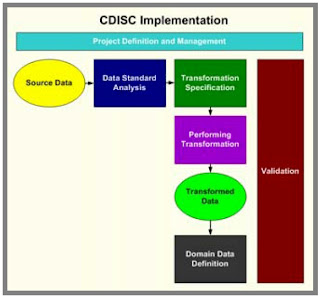CDISC Implementation for Dummies
There are some tasks within the process that can be applied asynchronously, but the majority of the steps depend on each other and therefore follow a sequence. The process is described below:

It is important to have a clear vision of the processes for the project before you start and to be aware that the effort is resource-intensive. This provides the ability to resource and plan for all the processes and enables adherence to deadlines and budgets. The organization and planning for this undertaking is an essential first step towards an effective implementation.
...
STEP 5: TRANSFORMATION SPECIFICATION – The specification for transforming to CDISC standards is a detailed road map that will be referenced and used by all team members during the transformation implementation and review. There can be different technologies used to perform this task. The following example utilizes tools including MS Excel and Transdata™. Dataset transformation is a process in which a set of source datasets and their variables are changed to meet new standard requirements. The following list describes some of the changes that can occur:
- Dataset Name - SAS dataset names must be updated to match SDTM standards, which require them to be no more than 8 characters in length.
- Dataset Label - The descriptive labels of SAS datasets must be modified to conform to SDTM standards.
- Variable Name - Each variable within a SAS dataset has a unique name. Variable names can be the same across different datasets, but if they share the same name, they are generally expected to possess the same attributes. Variable names are no more than 8 characters in length.
- Variable Label - Each variable has an associated label that describes the variable in more detail. Labels are no more than 40 characters in length.
- Variable Type - A variable’s type can be either character or numeric.
- Variable Length - A character variable can vary in length from 1 to 200 characters.
- Format - Variable format will be updated.
- Yesno - If the value of the variable is "yes", it will produce a new row with the newly assigned value of the label.
- Vertical - Multiple variables can be assigned to one variable that will produce a row if it has a value.
- Combine - Combine values of multiple source variables into one destination variable.
- Drop - The variable from the source dataset will be dropped when creating the destination data.
- Same - The same variable with all of the same attributes will be kept in the destination data.
- Value Change - This can have either a recoding of values or a formula change. This will change the actual values of the variable.
There may be other types of transformations, but these are the common transformation types that are usually documented in the specification. The transformation specification is stored in an Excel spreadsheet and is organized by tabs. The first tab named "Tables" contains a list of all the source tables. The subsequent tabs contain the transformation specifications for each source dataset as specified in the initial tables tab.
more details at: CDISC Papers , CDISC Software, Define.xml Software and SAS Outsourcing

Clinical trial is a research conducted in human volunteers to assess the protection and effectiveness of the investigational Drug/molecule.Clinical SAS programming. I have included the important models of CDISC:
ReplyDeletei) Operational Data Model (ODM) - it helps the activity of clinical details gathered from several resources to one operational data source. The resources of the details are paper CRF, eCRF, individual journal, etc.
ii) Analysis Data Model (ADM) - it describes a standard for analysis datasets that are used to generate mathematical reviews for regulating syndication. The dataset should be ready for analysis to be conducted using SAS techniques directly without any further perform on the details.
iii) Study Data Tabulation Model (SDTM) - it describes a conventional framework for data tabulations that are to be posted as part of a item application to a regulating power such as the FDA. The current edition being used is 3.1.1 SDTMIG.
iv) Laboratory Study Model (LSM) - it works towards the growth of a conventional model for purchase and interchange of lab details which is the biggest component of the Clinical Trial data.